Last updated: 31 May 2005
|
Last updated: 31 May 2005 |
This page documents the Meade Deep Sky Imager comments, tips, and photos. Contributions welcome. In order to showcase the DSI you may occasionally see images taken with other telescopes on this page.
Subject: Autostar and the LX200 Classic Sent: Tuesday, May 31, 2005 19:00:47 From: Chris Blainas (cmblainas@earthlink.net) I have read over your web site and I have a question regarding my 8 year old, 12" LX200 classic. By classic, I mean the square edge controller, not the Autostar. I would like to get the Meade DSI Pro. The software based field de-rotation sounds incredible. I asked the folks at Astronomics about this and they said the Drizzle technology (field de-rotation) would NOT work with my scope. I have several laptops, so I rarely use the hand controller except for the initial setup. I normally use The Sky5. Is there a way to adapt my scope or add to it to enable the Autostar features? I really to want to try out the DSI software features. Sorry if this sounds very stupid, but I'm not well versed in this area. Thanks, Chris BlainasMike here: The Autostar won't work with the LX200 classic. You could use the DSI but some capabilities would require an Autostar.
Subject: ETX 125 - First experience with a Meade DSI camera Sent: Tuesday, May 31, 2005 10:06:49 From: SIMON GREENWOOD (ozark1@btinternet.com) Please don't laugh too much, these are the second night (28th May) pictures from my Meade DSI - a present from my wife. I have had no previous experience of astrophotography and I need to improve my focussing skills. The problems encountered so far include difficulties with the USB drivers provided. New users must get the drivers from the Meade website or the drivers will crash and prevent the camera from working. In addition the autostar cable is far too short - can I extend this using a modem line (RJ-11 to female RJ-11) or do I need to get something more sophisticated? The good points are that the pictures already show stars to magnitude 14.5 and good detail even in light polluted skies. The pictures are in full colour as well. Image scale appears to be of the order of 8' across (Memo: need a focal reducer already). I'm pretty pleased with the Meade DSI and hope to get better pictures soon... Regards Simon Greenwood Grays, England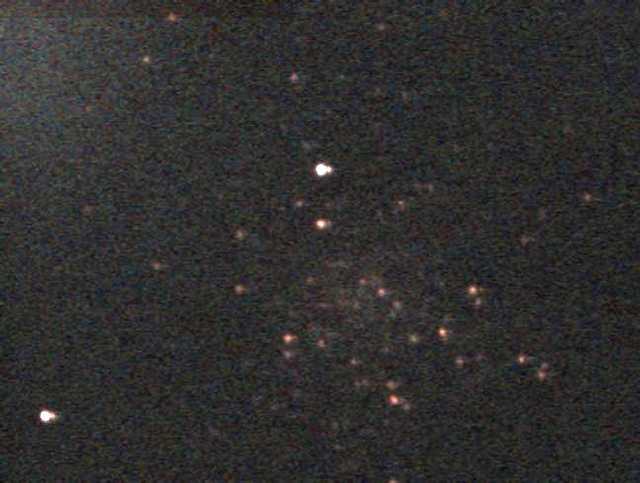
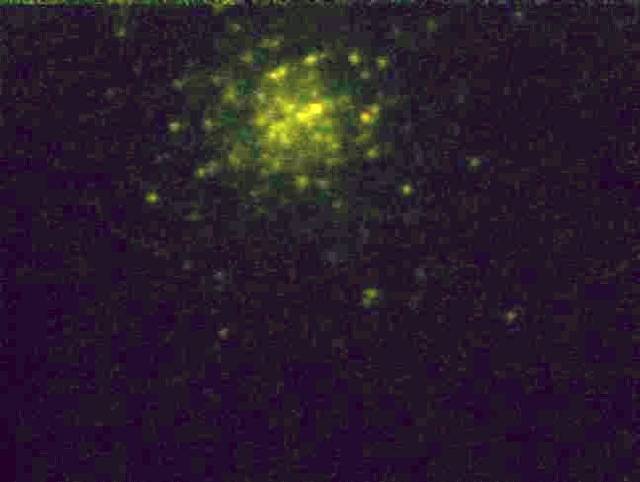
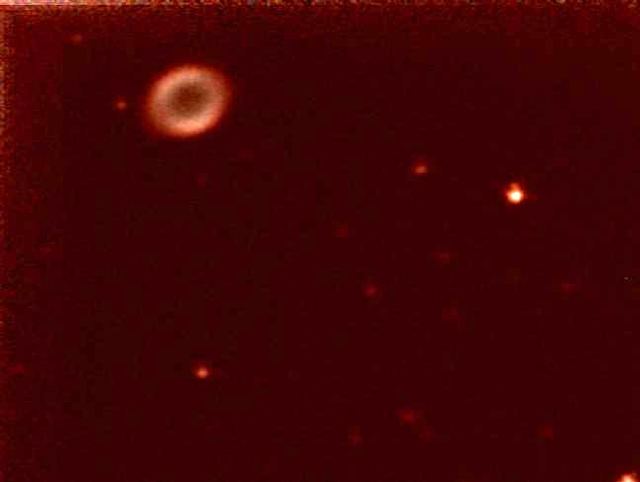
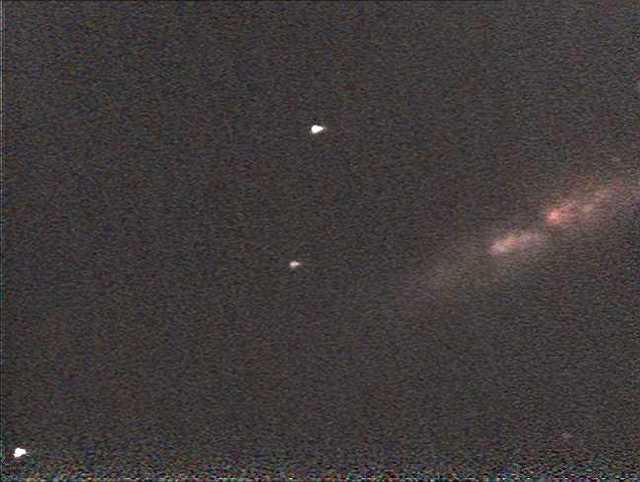
Subject: Couple more shots From the Greenhorn Sent: Sunday, May 29, 2005 21:20:44 From: M. J. The Madjordainain (madjordainian@insightbb.com) As promised a few more shots from the greenhorn on the DSI, I still have a lot of practice to conduct, but these are a little better than the first practice shots. End of May has been the first decent nights to attempt more astropics, the seeing has been not so good at best most of the nights I have had off this month. These images of M82 are a little better than the others I sent, Deep Sky2 Crop JPG is the first image of 05/28/05 and basically just an un-edited cropping of the FITS original exported as a .BMP and then cropped in another photo edit program. The other pics have has some refinement, but actually only some minor adjustments. Still having some issues with some objects, but I'm sure a focal reduce and a little better sky will help with that some, lose a lot of finer detail in some of the DSO's with brighter spots in them, I will still need to get some better software for stacking and merging images to improve upon some of that! Thanks Mike Later, The Mad One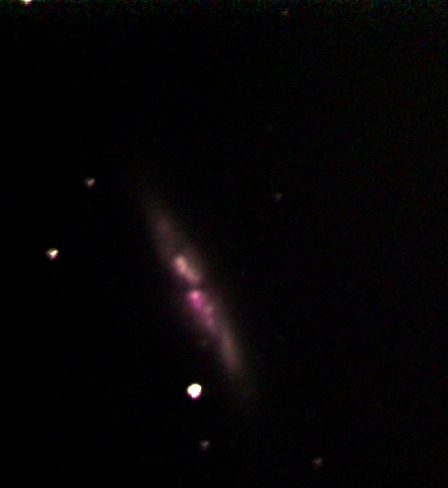
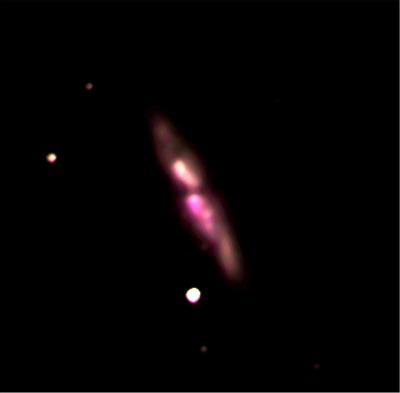
Subject: Re: Autostar Suite - "No imagers" message From: Pierre-Ren Beljean (prbeljean@bluewin.ch) Sent: 26 May 2005 Thank you for your suggestion to update the program from Meade website. My DSI was primarily not recognized, but after update it was possible to install the USB driver correctly and now its functions. (I have MS-Win XP SP2) Best regards. Pierre
Subject: DSI Pro / DSI Specification , to buy / not to buy Sent: Sunday, May 22, 2005 03:04:42 From: Stephen Bird (stephen.bird@btconnect.com) After my experience of the DSI (standard model as opposed to the new DSI Pro). I thought I would put pen to paper. When I initially bought the DSI in December 2004, my criteria were basically: 1. Price 2. Meade brand 3. Good advertising. In that order. A far as price is concerned, you would be hard pushed to find a CCD with the features, functionality and software in a single package for the DSI price. I am convinced Meade knows this and they sell the DSI based purely on price. The Meade name is world known and respected, strange as everyone I have met, in the UK, Europe and Australia all say Meade has the best product set, but everyone said they were a company that were hard to talk to when you had a problem, and the products always had problems! I have had my ETX replaced under warranty, two DSI's both with problems and two LPI's, the second one, is passable considering it is only really any good for what it says on the box, LUNAR, PLANETARY imaging. Nice shots of the moon, good shots of Jupiter, average shots of Saturn, and blurry discs of anything else. Little wonder they are now "one free with every Meade scope". I even had a motor board on a 12" LX200 GPS spontaneously fry on me for no apparent reason, the owners were not happy! Good advertising is what Meade is good at. Their website designer is their biggest asset, the site is continually updated, bright, colourful and packed with information on every product past and present that Meade has made. The website is what promotes their top customer buying criteria, Price. I digress. Looking beneath the advertising blurb, consider the product. The DSI does not boast the grade of the CCD sensor used. My understanding is that these things are graded from 1 to about 4, and the inspection process even classes the best batches as "better than grade 1". To put that in perspective, Starlight Xpress CCD camera's use the same line of Sony Exview HAD CCD sensors that the DSI uses, but they are willing to say that their sensors are grade 1 or better with no dead pixels. I have had both a LPI and DSI with bad pixels, the latter with 2 areas of bad pixels 16 x 8 pixels size each. These areas saturated at less than 0.5 seconds exposure and bloomed thereafter to give visible holes in every image. Again Starlight Xpress are willing to say that there are no more than 10 hot pixels saturated in <10 seconds. On my first DSI at 10 seconds I stopped counting when I got to 500 saturated pixels! Try it, put the lens cap on and set the exposure for 10 seconds, then count the saturated pixels! Anyway figuring I had got a bad LPI and bad DSI and was just unlucky, I have been considering the DSI Pro as a next step, but this time I have been checking the specs. One thing that struck me about the DSI Pro as a "nice to have" was the Drizzle technology, or is it just software? But take a look at the website, a few numbers don't stack up? The DSI Pro front page spec says the sensor is a Sony Exview HAD, 510 x 492 pixels. A bit of digging and I come up with the spec page at Sony and decide it is an ICX254AL, http://www.sony.net/Products/SC-HP/pro/image_senser/bw_video.html . But when I look at the Drizzle pages link on the Meade site, they talk about the DSI having a 640 x 480 pixel sensor, and multiplying it up to 2560 x 1920 or 1248 x 936 or 1280 x 960? Well the latter figures do feed from the 640 x 480 sensor size if using Drizzle, but the problem is that Sony don't do a 640 x 480 Exview HAD sensor? The Meade screen shots all show 640 x 480. So what is the deal here? It would be nice to talk to someone in Meade about it, but they don't answer e-mail even if you find an address on the website, and phoning them just gets a blank response. They seem happy to tell you to follow the instructions to load the software (even when those instructions are wrong), but step outside the obvious script, or mention that you are calling from the UK, and it is end of call! And the distributor in the UK is just a warehouse, nice warehouse people, really polite, desperate to help, astronomy is their hobby. But when it comes to proper technical questions on a Meade product, you can wait 4 weeks and still not get an answer worth having! They are at the mercy of Meade as much as we are. So the bottom line here: Do I go for a DSI Pro and hope for the best, exchanging it a couple of times until I get a good one from the "bad lot". Do I pay three times as much for a Starlight Xpress CCD, knowing that they advertise their phone number, fax number, sales e-mail and a tech info e-mail address and even their user forum gets answered by people from the company. Do I wait and see if Meade do to the DSI Pro what they did with LPI and DSI, upgrade within the year to something better. A Peltier cooled version with a 752 x 582 sensor would be nice. If the sensors were grade 1 or better, even nicer. If there were no more than 10 hot pixels saturated in <10 seconds, better still. And if the price was less than the Starlight Xpress, they would definitely make a sale. Regards Stephen BirdMike here: Decisions, decisions, decisions...
Subject: Meade DSI Experiences A Greenhorn's Input Sent: Monday, May 16, 2005 22:18:58 From: M. J. The Madjordainain (madjordainian@insightbb.com) I hope this message gets through to your site and it is of some use, help & encouragement to other users who may come to your site seeking help. I have had an interest and pursuit of amateur astronomy since I could look up at the night sky and see the stars. I never pursued the interest beyond a mediocre set of binocs & a couple of low quality scopes as there have always been other more pressing things requiring my financial support. I finally came off of a few dollars a couple of years ago and purchased a little better quality 8" Newtonian than the stuff I had used in years gone by. It was after this purchase that I began to more seriously pursue amateur astronomy, the looks I got through the 8" Newtonian were much more impressive than anything I had used in the past. I began to develop an interest in the astrophotography after I began to really get some good looks at some of the more pronounced deep sky objects. I started surfing about the 'net' seeking info on equipment for some photographic captures, the Meade DSI had just begun to appear on some of the sites I was visiting, perfect timing (for Meade). "You can begin taking photos like these your first night out!" I had looked at some of the SAC cameras also, they seemed a bit out of my realm of experience, and so I chose the DSI. What follows are my experiences to date in attempting to get some images, some OK, some very frustrating. When I finally got my computer equipment up to standard I set about the task. The computer is a 700Mhz PIII; Win98SE; 256MB RAM; machine with 2 USB 1.1 ports, should have managed the DSI by Meade's' Minimum System Req. First attempts at terrestrial images turned up some minor problems due to focus issues & lack of decent targets at good enough distance to be useful, BUT images did show up in the Live screen. First night out was abysmal as were a few other nights, Problems with contrast issues, double imaging, inability to pick up DSOs, Yada, yada, yada! It became obvious from following the experiences posted on your site Mike and others, things just weren't working out possibly due to a bad camera. I contacted Meade and after a few weeks of getting 'jerked around' via phone I wrote another letter expressing my complete dissatisfaction in Meade's' support blow off, faulty equipment and my intentions of holding Meade to It's promises. After they received the second letter from me, the first was a request for support with sample images, system specs, & such, I had another phone call from a representative informing me I had a bad camera and Meade would be sending me a new one. After I received the second camera things began to improve. Under the same setup I actually got a few images of Jupiter, M82, M81, M51, Saturn, & M101. The best were of M82 & Jupiter, rough but recognizable. It was somewhat depressing to realize that I had wasted away the Winter/early Spring sky trying to get a defective camera to work, but patience & determination has finally yielded a couple of recognizable images, they are not very good, but I have seen worse posted on sites about the 'net'. With time and practice I think my images will improve, along with the addition of some better image processing software. I hate to be so long winded in sharing my experiences, but hopefully it will help some other 'greenhorn' like me if they happen to come across this as a post when they go surfin for help; on to some of the "highlights" and points of interest. 1.) Most important, don't get so frustrated you give up on your new adventure in astro-imaging. 2.) Before you waste a lot of time getting nothing but failure, consider the possibility of a faulty unit, I can say from experience that was the cause of my first problems. 3.) Start off by getting your camera par focal with an eyepiece, I used a 17MM it just seemed to work best of all the eye pieces, try different ones initially, different setups for different scopes! Once you think you are focused find a 1.0 - 2.0 Mag star and do it again, this will help you to get a finer 'feel' for the focus. Take some images of your 'focal target star'; play with the 'Auto Expo' timing to find out how the timing on your exposures makes your target appear (in other words... how it works). 4.) Nix the auto contrast, once you have gotten a feel for the exposure settings using your target star move on to a planet. I used Jupiter, very bright and easy target, first let the DSI software attempt to gain a useable image setting by clicking the "Auto Expo" button. Give the software some time to run through the timer settings to gain a better image. After the Auto is through go to the timer adjustment and fiddle with it yourself to see if you can get a finer tuned image on the 'live' screen. Play with the histogram settings to see the effects of adjusting it; careful it's very sensitive using the sliders I suggest using the scroll arrows on each of the control boxes. Also a Hartmann mask of some type is a must for bright objects. 5.) Once your planet looks good in the live image screen, try some images using the FITS3p as your save setting and adjust your quality to minimum 20% for the align & combine, let it take at least 35 - 50 images for combining. See what you get, try some more images playing with the setups don't be in too big of a hurry to get those great images your "first night out"! Practice on your planet for a bit to get the hand of it. 6.) OK time to try for one of the brighter DSOs, this is where you begin to better learn about setting up your exposure times, I used M81 & M82. Go to the 'Preview' button and check the long exposure box once you have established your target. Establishing your target is just that, use the Auto Exposer just enough to confirm you are seeing the target. Once established begin setting your preview timings up, if you can begin to see the DSO better at 8.0 seconds in the live screen begin setting your preview screen up at 9.0 seconds and ease it up from there to see at what timer setting you begin to get good images at. Once you have a timer setting that looks OK take some images using that setting, use the align & combine and get a composite of a few images to combine later with more images taken at different timings. 7.) Be patient and just try to get used to & learn how to adjust your histogram/contrast vs. timer settings to get your first images. Don't expect very good images if it is not a good night for 'seeing' in the first place. Expect to spend some nights practicing and refining your image shooting settings and techniques. I have just touched the bases with the above, I still have much to learn and practice, but doing things this way has shown me it can be done. Your telescope needs to be setup properly too, reasonably polar aligned, with a good tracking setup. Mine is a motorized German Equatorial and once aligned tracks well, I've now taken some 45+ second X 5 image exposures of a very faint target and my tracking stayed true between the mount & the DSI software. If I can manage this with my limited experience it can be done if you have a functional DSI and my telescope isn't all that great, not compared to most of the Schmidts & Maksutovs everyone else is using. I'll send along a couple of my practice shots in a second email, but they are pretty poor. When the sky around here get a little better maybe I can get some fair images to forward along to you, thanks for your site! Mark JordanAnd:
These were actually a little better before I messed around with them experimenting with some different editing software. As they were practice shots I neglected to save copies of the originals, but anywho's here are a couple of shots! Oh well when I get some better images I'll send some to you. Jordan
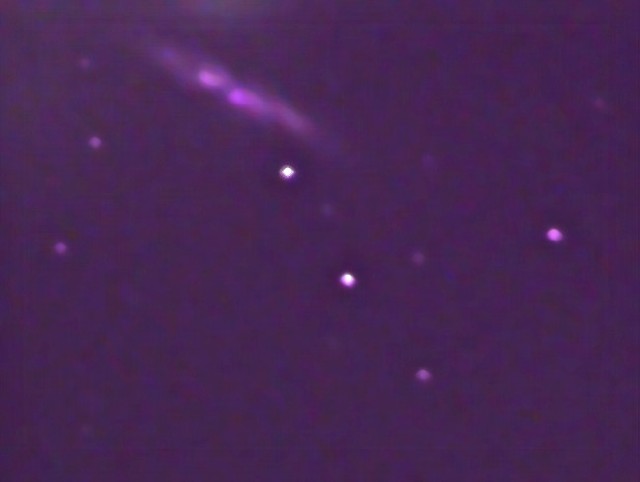
Subject: M53 with Meade DSI Sent: Tuesday, May 10, 2005 05:55:36 From: Bernhard Rems (bgrems@viennamet.com) please find attached a picture of M53, taken with the Meade DSI on a LX90 f/6.3. This is a total exposure of less than 5 minutes (19x15 seconds). Once again, the power of the DSI amazes me.Bernhard 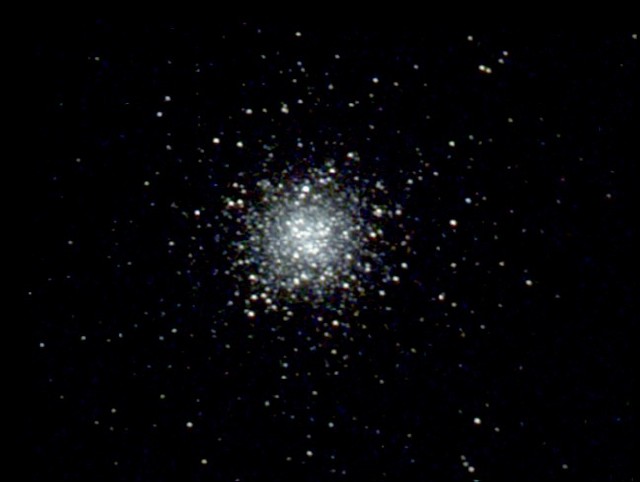
Subject: Deep Sky Imager problems Sent: Sunday, May 8, 2005 11:42:01 From: michael@caldwell.me.uk (michael@caldwell.me.uk) I wonder if any of yur readers can help me out. I bought a DSI in Feb and have yet to get an astronomical image from it. I managed to set the imager up for terrestrial work but whenever I set up in the evening for night sky use I either do not get any image or the image fails after aprox 1-2 mins. I am using a Compaq laptop bought in January with 1GB Ram. System analysis shows that the drivers are in use when I connect the camera. Even for terrestrial use what usually happens, if there is an image on connection, is that the image disapppears after about 1-2 mins leaving just random noise. The imager is still connected to the DSI software but no image comes through. I have removed and reintalled Autosuite and the drivers many times. The DSI software controls do react even without an image. If I load the software without the imager connected I get a message to say no imager and the picture window is a standard even grey. When I connect the imager and run the software no error message occurs and the picture window is random noise which is continually changing. As you can imagine this is all very frustrating. Michael Caldwell
Subject: Meade DSI picture of NGC 2903 Sent: Friday, April 29, 2005 01:41:44 From: Bernhard Rems (bgrems@viennamet.com) here is a picture of NGC 2903 (a spiral galaxy in Leo) I made with the Meade DSI on a LX90 f/3.3. It's a composite of 30 pics with 30 seconds each, totalling 15min. Processing was done in Maxim DL. Not too bad for the third night out, I think.Bernhard 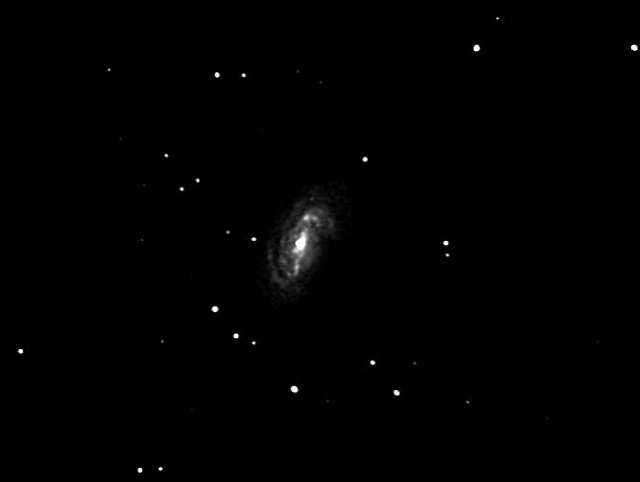
Return to the top of this page.
Go to the March-April 2005 DSI Page.
Go to the January-February 2005 DSI Page.
Go to the 2004 DSI Page.
Go back to the Astrophotography Page.
Go back to my ETX Home Page.